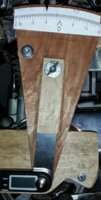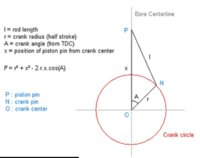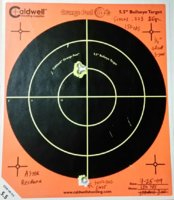Now, the findings.
The pencil tracks show well defined piston position events.

From each of the (4) events, draw radial lines down to the degree strip edge.

Certainly doesn't look centered.
Overlay one of the smaller degree strips over the marked strip. Keep the 9" radius in alignment. Adjust the strip's position to get equal degree spacings from the event marks.

Slowly rotate the crankshaft to get the pointer atop this new TDC position.
The tiny tic mark above the new strip's 1 degree mark is from the original degree strip's TDC location. Looks to be off by 1 degree.
Check the digital protractor.

It agrees, off by 1 degree. The rotor mark is about 1mm left of the stator mark.
The pencil tracks show well defined piston position events.
From each of the (4) events, draw radial lines down to the degree strip edge.
Certainly doesn't look centered.
Overlay one of the smaller degree strips over the marked strip. Keep the 9" radius in alignment. Adjust the strip's position to get equal degree spacings from the event marks.
Slowly rotate the crankshaft to get the pointer atop this new TDC position.
The tiny tic mark above the new strip's 1 degree mark is from the original degree strip's TDC location. Looks to be off by 1 degree.
Check the digital protractor.
It agrees, off by 1 degree. The rotor mark is about 1mm left of the stator mark.
Last edited:








